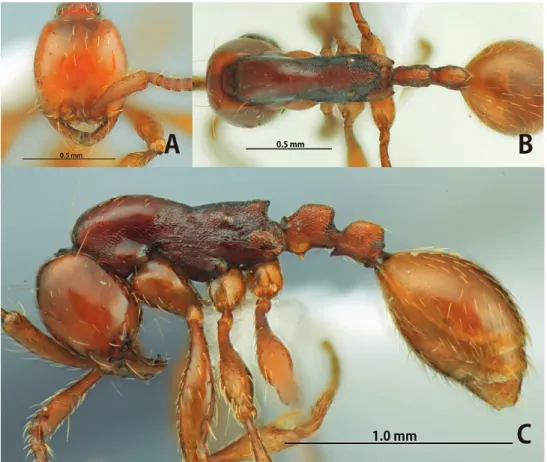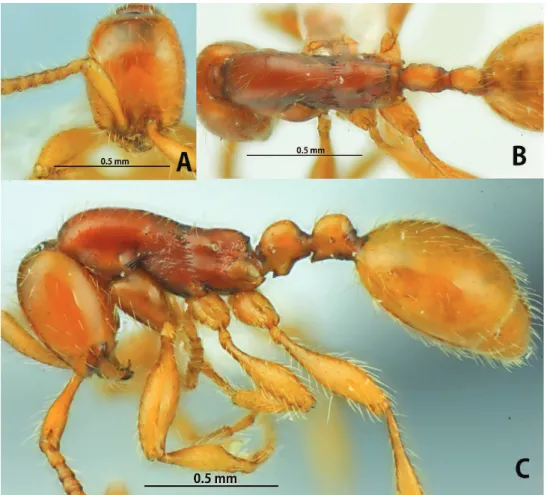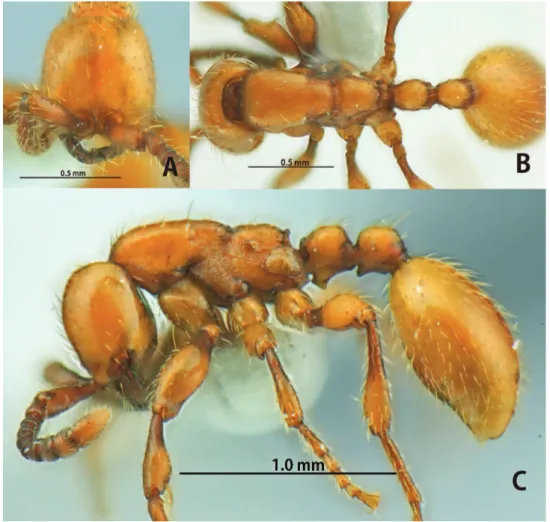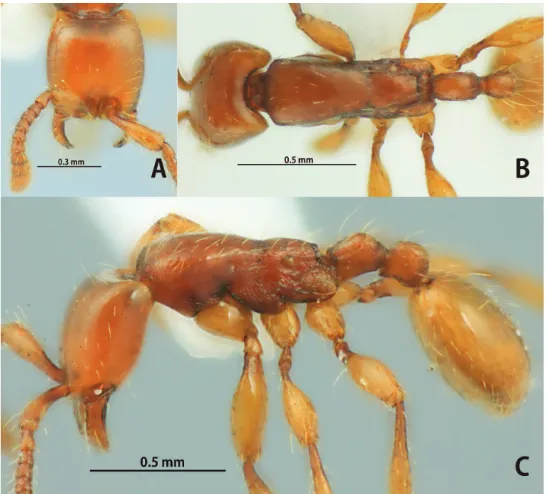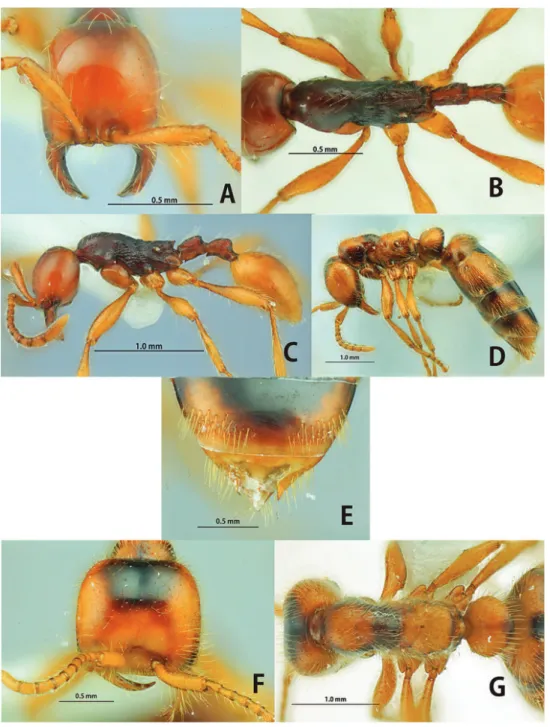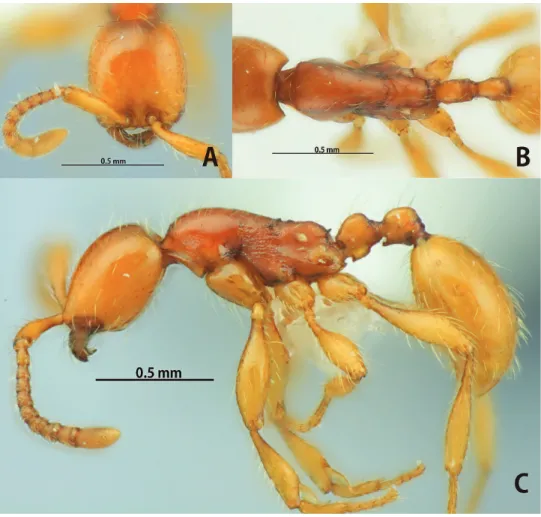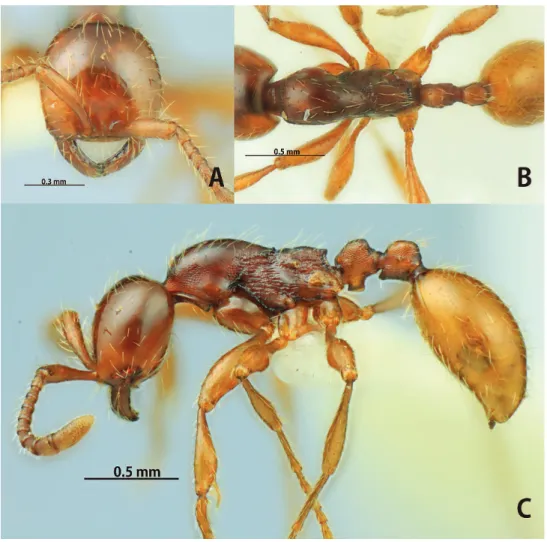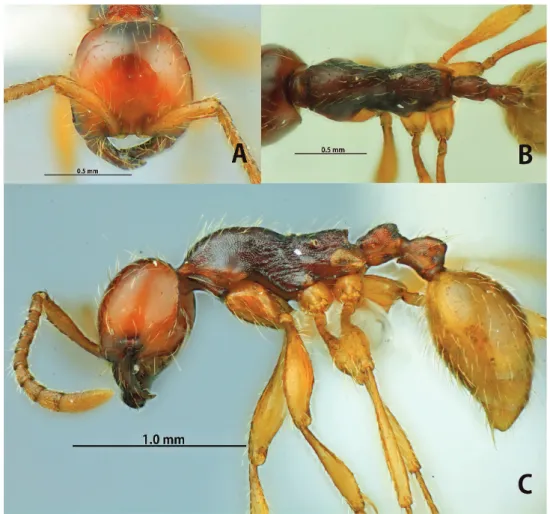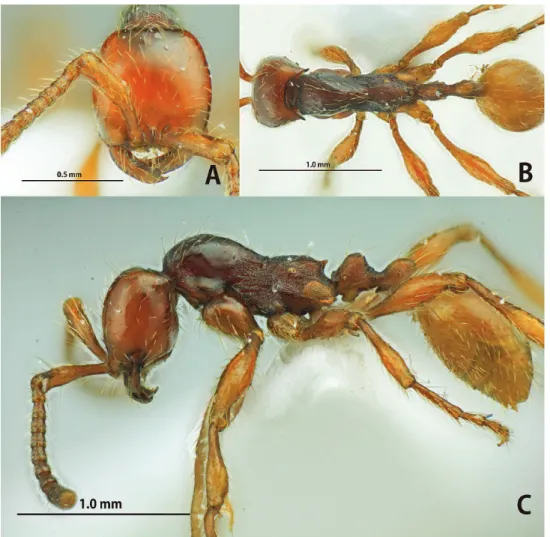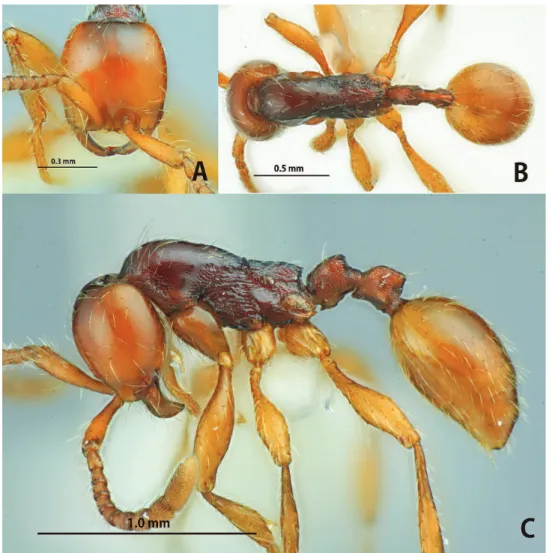The
Aenictus ceylonicus
species group (Hymenoptera,
Formicidae, Aenictinae) from Southeast Asia
Weeyawat Jaitrong1,†, Seiki Yamane2,‡
1 Natural History Museum, National Science Museum, Technopolis, Khlong 5, Khlong Luang, Pathum Thani, 12120 Thailand 2 Graduate School of Science and Engineering, Kagoshima University, Kagoshima, 890-0065 Japan
† urn:lsid:zoobank.org:author:E456F06F-486F-4BD5-AEE6-6DCA639C3E27 ‡ urn:lsid:zoobank.org:author:C20D11CC-8F51-4D35-A1F8-D01D9536934F
Corresponding author:Weeyawat Jaitrong (polyrhachis@yahoo.com)
Academic editor:W. Pulawski | Received 9 November 2012 | Accepted 9 February 2012 | Published 20 March 2013
urn:lsid:zoobank.org:pub:FAAB4704-9E2C-438C-BA06-B4FAFC6E8CB5
Citation: Jaitrong W, Yamane Sk (2013) The Aenictus ceylonicus species group (Hymenoptera, Formicidae, Aenictinae) from Southeast Asia. Journal of Hymenoptera Research 31: 165–233. doi: 10.3897/JHR.31.4274
Abstract
The genus Aenictus is a diverse group of army ants in the Old World tropics and subtropics. The Southeast Asian species of the Aenictus ceylonicus group are revised to include twenty-three species (4 named and 19 new species): Aenictus appressipilosus sp. n., A. baliensis sp. n., A. brevipodus sp. n., A. concavus sp. n., A. cylindripetiolus sp. n., A. eguchii sp. n.,A. formosensis Forel, 1913 stat. n.,A. fuchuanensis Zhou, 2001,
A. gonioccipus sp. n., A. itoisp. n., A. jawadwipasp. n., A. khaoyaiensis sp. n.,A. lifuiae Terayama, 1984,
A. longicephalus sp. n.,A. maneerati sp. n.,A. minipetiolus sp. n.,A. pilosus sp. n.,A. pinkaewi sp. n.,A. sundalandensissp. n., A. thailandianus Terayama & Kubota, 1993, A. watanasiti sp. n., A. wilaiae sp. n.,
and A. wiwatwitayai sp. n. Aenictus ceylonicus var. formosensis Forel is removed from synonymy with A. cey-lonicus and raised to full species. Lectotype and paralectotypes are designated for A. ceylonicus. Redescrip-tions of Aenictus ceylonicus (Mayr, 1866) (India and Sri Lanka) andA. doryloides Wilson, 1964 (India) are provided. The queen of A. cylindripetiolus is described. A key to the Southeast Asian species of the group is given based on the worker caste. Most of the Southeast Asian species of this species group have more or less limited distribution ranges. This may be due to the poor dispersal ability generally seen among the Aenic-tus species, in which the propagule (reproductive unit) is an apterous queen plus accompanying workers.
Keywords
Army ants, Aenictus ceylonicus species group, taxonomy, Southeast Asia
www.pensoft.net/journals/jhr
introduction
Aenictus Shuckard, 1840 (subfamily Aenictinae) is one of the true army ant genera (Wilson 1964, Gotwald 1995). Most species of the genus are specialized predators of other ants, especially of immature stages (Gotwald 1976, 1995, Rościszewski and Maschwitz 1994). Only some Asian species such as Aenictus gracilis Emery, Aenictus laeviceps (Fr. Smith), Aenictus hodgsoni Forel, and Aenictus paradentatus Jaitrong & Yamane are known to hunt a variety of invertebrate prey, including ants, using a large number of workers in raids (Gotwald 1995, Hirosawa et al. 2000, Shattuck 2008, Jaitrong and Yamane 2011, Jaitrong et al. 2012). Foraging raids undertaken by these ants occur both day and night, usually across the ground surface but occasionally also in trees (Yamane and Hashimoto 1999). During raids, numerous workers attack ant nests in a small area, with several workers coordinating their efforts to carry large prey items back to the nest or bivouac.
The genus is one of the larger ant genera of the world. Currently 187 valid species and subspecies names are listed (http://www.antwiki.org/Category:Aenictus_species). In Southeast Asia, 80 species have been named. Among them 57 species belonging to 12 species groups are known only from the worker caste (Jaitrong and Yamane 2011, Jaitrong and Yamane 2012, Jaitrong and Hashimoto 2012). Several papers have discussed the species groups of Aenictus. The first paper evaluating species groups is Wilson (1964), in which he divided Asian, New Guinean and Australian members of the genus into seven distinct groups based on certain hypothesized “unique, un-reversed” characters. Jaitrong and Yamane (2010) established the Aenictus silvestrii group to include three Southeast Asian species with less than 10 antennal segments. Jaitrong et al. (2010) treated seven Oriental and Indo-Australian species that have yellowish and slender body with long legs and antennae as belonging to the Aenictus wroughtonii group. Wiwatwitaya and Jaitrong (2011) treated two Southeast Asian species (Aenictus hottai Terayama & Yamane and Aenictus yamanei Wiwatwitaya & Jaitrong) that have reticulated first gastral tergite as belonging to the Aenictus hottai group. Jaitrong and Yamane (2011) established 12 species groups in the genus and revised the species of two species groups (Aenictus currax and Aenictus laeviceps groups) from the eastern part of the Oriental region, and Indo-Australian and Australasian regions. Jaitrong and Yamane (2012) revised the Aenictus javanus group to include six species and the Aenictus philippinensis group to include four species from Southeast Asia. Lastly, Jaitrong and Hashimoto (2012) treated six Southeast Asian species of the Aenictus minutulus group.
Materials and methods
Sources of materials
This study is mainly based on the materials deposited in the SKY collection at Kagoshima University (Japan), Ant Museum of Kasetsart University (Thailand) and The Natural History Museum of the National Science Museum (Thailand). Holotypes, paratypes and syntypes of named species were loaned from the following museums, institutions, and private collections listed below. For their abbreviations we mainly follow Bolton (2007).
AMK Ant Museum, Faculty of Forestry, Kasetsart University, Thailand.
BMNH The Natural History Museum, London, U.K.
MCZC Museum of Comparative Zoology, Cambridge, MA, U.S.A.
MHNG Museum d’Histoire Naturelle, Geneva, Switzerland.
MZB Museum Zoologicum Bogoriense, Cibinong, Indonesia.
NHMW Naturhistorisches Museum, Wien, Austria.
NIAST The National Institute of Agro-Environmental Sciences, Tsukuba, Japan.
SKYC SKY Collection at Kagoshima University, Japan.
TARI Taiwan Agricultural Research Institute, Taiwan.
THNHM Natural History Museum of the National Science Museum, Thailand.
UMS ‘BORNEENSIS’, Universiti Malaysia Sabah, Sabah, Malaysia.
VNMN Vietnam National Museum of Nature, Hanoi, Vietnam.
WJT Weeyawat Jaitrong
Observation
Most morphological observations were made with a Nikon SMZ1000 stereoscope. Multi-focused montage images were produced using Helicon Focus 4.75 Pro from a series of source images taken by a Canon EOS Kiss×4 digital camera attached to a Nikon ECLIPSE E600 microscope. When fine hairs and other parts which were not recognized automatically were found, the focused parts from the source images were copied to the montage image using the retouching function of Helicon Focus. Arti-facts (ghost images) and unnecessary parts (unfocused appendages, etc.) surrounding or covering target objects were erased and cleaned up using the retouching function of Helicon Focus. Finally, the background was cleaned up, and the color balance, contrast and sharpness were adjusted using Adobe Photoshop Elements 7.
Measurements and indices
The abbreviations used for the measurements and indices are as follows:
CI Cephalic index, HW/HL × 100.
HL Maximum head length in full-face view, measured from the anterior clypeal margin to the midpoint of a line drawn across the posterior margin of the head.
HW Maximum head width in full-face view.
ML Mesosomal length measured from the point at which the pronotum meets the cervical shield to the posterior margin of metapleuron in profile.
PL Petiole length measured from the anterior margin of the peduncle to the poste-riormost point of tergite.
SI Scape index, SL/HW × 100.
SL Scape length, excluding the basal constriction and condylar bulb.
TL Total length, roughly measured from the anterior margin of head to the tip of gaster in stretched specimens.
The general terminology in the worker caste of the ants follows Hölldobler and Wilson (1990), and Bolton (1994). For the important characters in the genus Aenictus used in this paper, see Jaitrong and Yamane (2011).
Taxonomy
Aenictus ceylonicus species group
Diagnosis.Jaitrong and Yamane (2011) defined this species group as follows: antenna 10-segmented; with head in full-face view scape extending beyond half of head length, but not reaching the occipital corner of head; mandible linear; its basal and exter-nal margins almost parallel; masticatory margin with large apical tooth followed by medium-sized subapical tooth; 0-6 small denticles present between subapical tooth and basal tooth; with mandibles closed, a gap present between mandibles and anterior margin of clypeus; anterior clypeal margin weakly concave or almost straight, lacking denticles; frontal carina short and thin reaching to or extending a little beyond the level of posterior margin of torulus; with head in full-face view curved anterior extension of frontal carina reaching to or extending beyond the level of anterior clypeal margin; par-afrontal ridge absent; promesonotum usually convex dorsally and sloping gradually to propodeum (rarely with almost straight dorsal outline); subpetiolar process developed.
Head and first gastral tergite smooth and shiny. Body yellowish, reddish or dark brown; typhlatta spot absent.
List of South Asian species
1. Aenictus appressipilosus sp. n. (Borneo) 2. Aenictus baliensis sp. n.(Bali)
3. Aenictus brevipodus sp. n. (Vietnam)
4. Aenictus concavus sp. n.(Vietnam and Thailand) 5. Aenictus cylindripetiolus sp. n.(Thailand) 6. Aenictus eguchii sp. n.(Vietnam)
7. Aenictus formosensis Forel, 1913, stat. n. (Taiwan)
8. Aenictus fuchuanensis Zhou, 2001 (China, Laos and Thailand) 9. Aenictus gonioccipus sp. n. (Sulawesi)
10. Aenictus itoisp. n. (Sumatra)
11. Aenictus jawadwipasp. n. (Sabah, Sarawak and Java) 12. Aenictus khaoyaiensis sp. n. (Thailand)
13. Aenictus lifuiae Terayama, 1984 (southernmost part of Japan and Taiwan) 14. Aenictus longicephalus sp. n. (Lombok)
15. Aenictus maneerati sp. n. (Thailand) 16. Aenictus minipetiolus sp. n. (Lombok) 17. Aenictus pilosus sp. n. (Philippines) 18. Aenictus pinkaewi sp. n. (Thailand)
19. Aenictus sundalandensissp. n. (Sumatra, Borneo and Java)
20. Aenictus thailandianus Terayama & Kubota, 1993 (Vietnam and Thailand) 21. Aenictus watanasiti sp. n. (Thailand)
22. Aenictus wilaiae sp. n. (Thailand) 23. Aenictus wiwatwitayai sp. n. (Thailand)
Key to Southeast Asian species based on the worker caste
1 Mandible with 2-6 teeth/denticles between subapical and basal teeth (mandi-ble with more than 4 teeth/denticles) (Figs 11C, 17B) ...2 – Mandible with 0-1 tooth/denticle between subapical and basal teeth (mandi-ble with 3-4 teeth/denticles) (Figs 13D, 18B) ...15
2 Dorsal face of propodeum mostly smooth and shiny; lateral face of propo-deum partly smooth and shiny; postpetiole entirely smooth and shiny (Figs 12B, 14B). ...3 – Propodeum entirely sculptured; postpetiole entirely sculptured or with
smooth and shiny small area on dorsal face (Figs 5B, 16B, 22B) ...6
3 Declivity of propodeum with lateral carinae, but not demarcated basally by a transverse carina (Fig. 12B, C) (Lombok) ...A. longicephalus sp. n. – Declivity of propodeum shallowly concave, encircled with a rim (Figs 2B,
4 Distal 2/3 of basal margin of mandible straight, proximal 1/3 narrowed to-ward base of mandible; anterior clypeal margin straight; petiole clearly small-er than postpetiole (Fig. 14C) (Lombok) ...A. minipetiolus sp. n. – Basal margin of mandible feebly concave; anterior clypeal margin concave;
petiole larger than or as large as postpetiole (Figs 2C, 20C) ...5
5 Promesonotum strongly convex and sloping gradually to metanotal groove; subpetiolar process with angulate posteroventral corner (Fig. 2C); antennal scape relatively long (SI 78-86) (Bali) ...A. baliensis sp. n. – Mesosoma almost flat dorsally or feebly convex; subpetiolar process lower,
with its posteroventral corner rounded (Fig. 20C); antennal scape relatively short (SI 57-78) (Vietnam and Thailand) ...A. wiwatwitayai sp. n.
6 Vertex with 2 long standing hairs mixed with a few short appressed hairs; promesonotum with few appressed hairs and a few decumbent hairs (Fig. 1C) (Sabah) ...A. appressipilosus sp. n. – Vertex and promesonotum with dense standing or decumbent hairs (Figs
10C, 13C, 15C, 16) ...7
7 Promesonotum entirely sculptured (punctate or reticulate) ...8 – Promesonotum largely smooth and shiny ...9
8 Promesonotum sparsely reticulate and shiny or superficially micropunctate (entire promesonotum looks shiny); antennal scape superficially shagreened; petiole cylindrical, clearly longer than high (Fig. 5C) (S. Thailand) ... ...A. cylindripetiolus sp. n. – Promesonotum densely punctate and matt; antennal scape micropunctate;
petiole round or subangulate, almost as long as high (Fig. 17D) (Vietnam and N. Thailand) ...A. thailandianus Terayama & Kubota
9 With head seen in profile and dorsal view occipital corner produced as a small lobe (Fig. 9C) (Sulawesi) ...A. gonioccipus sp. n. – With head seen in profile occipital corner without such a lobe (Figs 15C,
23C) ...10
10 Masticatory margin of mandible with large acute apical tooth followed by a series of 6-7 denticles of two sizes, the larger alternating with 1-2 smaller (Fig.11C); gap between anterior clypeal margin and mandibles relatively small or indistinct, with maximum width shorter than maximum width of mandible (S. Japan and Taiwan) ...A. lifuiae Terayama – Masticatory margin of mandible with large acute apical tooth followed by a me-dium-sized subapical tooth, 2-5 denticles, and a meme-dium-sized basal tooth (Fig. 17B); gap between anterior clypeal margin and mandibles relatively large and distinct, with maximum width longer than maximum width of mandible ...11
– Subpetiolar process subrectangular or low, convex in its ventral outline, an-teroventrally always angulate (Figs 1C, 9C, 23C); postpetiole with roundly convex dorsal outline (Figs 9C, 23C) ...12
12 Subpetiolar process rectangular, ventrally with anterior and posterior corners (Figs 6C, 23C) ...13 – Subpetiolar process low, its ventral outline convex, almost straight or feebly
concave, and anteroventral corner acutely angulate (Figs 15C, 19C) ...14
13 Posteroventral corner of subpetiolar process bluntly angulate (not spiniform) (Fig. 6C); dorsal outline of propodeum weakly convex; metapleural gland bulla weakly sculptured and shiny (Vietnam) ...A. eguchii sp. n. – Posteroventral corner of subpetiolar process acutely produced below (spini-form) (Fig. 23C); dorsal outline of propodeum straight; metapleural gland bulla strongly sculptured (puncto-reticulate) and opaque (Borneo and Java) . ...A.jawadwipa sp. n.
14 Promesonotum in profile weakly convex (Fig. 19C); propodeal dorsum feebly convex; petiole sessile with low node, its posterior face encircled with a thin carina; postpetiole almost as long as petiole (Thailand) ... A. wilaiae sp. n. – Promesonotum in profile strongly convex and forming a dome (Fig. 15C);
propodeal dorsum clearly straight; petiole subsessile with high node, its pos-terior face not encircled with a carina; postpetiole slightly shorter than petiole (Philippines) ...A. pilosus sp. n.
15 Mandible with 3 teeth including apical and basal teeth (Fig. 18B). ... 16 – Mandible with 4 teeth including apical and basal teeth (Fig. 13D). ... 17 16 With head seen in profile occipital corner round; promesonotum in profile
strongly convex and forming a dome (Fig. 18D); petiole almost as long as high, with high node, and almost as long as postpetiole (Vietnam and Thai-land) ...A. watanasiti sp. n.
– With head seen in profile occipital corner roundly angulated (almost right-angled) (Figs 4C); promesonotum in profile with weakly convex or almost flat dorsal outline (Fig. 4C); petiole clearly longer than high, with low node, and slightly longer than postpetiole (Vietnam and Thailand) ...A. concavus sp. n.
17 Dorsal and lateral faces of pronotum largely smooth and shiny; petiole almost as long as high; head slightly longer than or almost as long as broad (CI 90-100) ...18 – Dorsal and lateral faces of pronotum entirely sculptured (superficially punc-to-reticulate, punctate to reticulate); petiole cylindrical, distinctly longer than high; head slightly shorter than broad (CI 102-112) ...20
– Anterior clypeal margin almost straight or feebly concave; metanotal groove indistinct; foretibia relatively long, its length about 0.9-1.0 times as long as head width; mesopleuron with some longitudinal rugulae ... 19 19 Subpetiolar process low, ventral outline weakly convex, its anteroventral cor-ner angulate (Thailand) ...A. khaoyaiensis sp. n.
– Subpetiolar process well-developed, subrectangular with convex ventral la-mella, and with anterior and posterior corners acutely or bluntly angulated (Taiwan) ...A. formosensisForel, stat. n. 20 Subpetiolar process very low, with anterior and posterior denticles that pro-trude downward (Fig. 13C); head in full-face view rectangular, its posterior margin feebly concave (Fig. 13A) (Thailand) ...A. maneerati sp. n.
– Subpetiolar process subrectangular or low, with its anteroventral corner acutely angulated and ventral outline straight or convex (Figs 8C, 22C); head in full-face view subrectangular or rounded, its posterior margin weakly con-cave, almost straight or weakly convex (Figs 8A, 16A, 22A) ...21
21 Pronotum with central area superficially shagreened or rather smooth and shiny, and with lateral face reticulate and shiny; subpetiolar process low, with its anteroventral corner acutely angulate and ventral outline concave (Fig. 22C) (Sumatra, Borneo and Java) ...A. sundalandensis sp. n.
– Pronotum micropunctate or reticulate and opaque (at most weakly shiny); subpetiolar process always low, with its anteroventral corner acutely angulate and ventral outline almost straight or convex (Figs 8C, 16C) ...22
22 Pronotum entirely strongly punctate (N. Thailand) ...A. pinkaewi sp. n.
– Anterior portion of pronotum densely punctate, lateral face of pronotum finely reticulate (China, Hong Kong, Laos and Thailand) ...A. fuchuanensis Zhou
Aenictus appressipilosus sp. n.
urn:lsid:zoobank.org:act:D2963B2E-90E3-4E37-A2B9-512D22442347 http://species-id.net/wiki/Aenictus_appressipilosus
Fig. 1A–C
Type material examined. Holotype.MALAYSIA: Worker from E. Malaysia, Borneo, Sabah, Tawau Hills N.P., 7.VII.1996, leg. Sk. Yamane, SB96-SKY-01 (UMS). Para-types.Eight workers, same data as holotype (SKYC, THNHM).
Non-type material examined.MALAYSIA: E. Malaysia, Borneo, Sabah, Danum Valley, 3.XI.1996, K. Eguchi leg., Eg96-BOR-153 (SKYC, THNHM).
Worker measurements (holotype and paratypes, n = 9). TL 2.70-2.85 mm; HL 0.58-0.60 mm; HW 0.54-0.55 mm; SL 0.45-0.48 mm; ML 0.90-0.95 mm; PL 0.25-0.28 mm; CI 92-93; SI 84-88.
relatively long, extending beyond 2/3 of head length but not reaching posterolateral corner of head. Frontal carina relatively long, slightly extending beyond the level of posterior margin of torulus. Parafrontal ridge indistinct, slightly extending beyond the level of posterior margin of torulus. Anterior clypeal margin almost straight or feebly concave. Masticatory margin of mandible with large acute apical tooth followed by a medium-sized subapical tooth, and 5-6 denticles; basal margin almost straight. Maxi-mum width of gap between anterior clypeal margin and mandibles about 1.8 times as broad as maximum width of mandible. Promesonotum convex dorsally and slop-ing gradually to metanotal groove; metanotal groove indistinct; mesopleuron relatively long, not clearly demarcated from metapleuron; metapleural gland bulla relatively small, its maximum diameter about 1.8 times as long as distance between propodeal spiracle and metapleural gland bulla. Propodeum in profile with straight dorsal out-line; propodeal junction acutely angulate, overhanging the declivitous face; declivity of propodeum seen from back tapering above, shallowly concave, and encircled with a thin rim. Petiole in profile trapezoidal, slightly longer than high, with straight dorsal outline; anterior slope of petiole seen in profile feebly concave; subpetiolar process low with anterior corner angulated and posteroventrally produced into a spine with acute
tip, margin connecting anterior corner and base of the spine weakly concave. Postpeti-ole shorter than petiPostpeti-ole, with its dorsal outline convex.
Head and gaster entirely smooth and shiny. Mandible very finely striate. Anten-nal scape superficially microreticulate, apical half slightly shiny. Mesosoma reticulate (reticulation coarser on lateral face of pronotum than on propodeum) except for an-teriormost portion of pronotum punctate; promesonotal dorsum smooth and shiny; mesopleuron with relatively irregular longitudinal rugae.
Head with a pair of long standing hairs mixed with sparse short appressed hairs over the surface; mesosoma dorsally with relatively sparse appressed hairs mixed with 2-4 decum-bent hairs; longest pronotal hair (decumdecum-bent hair) 0.10-0.13 mm long. Antennal scape, mesosoma, petiole and postpetiole reddish brown; head, gaster and legs yellowish brown.
Etymology.The specific name refers to the appressed hairs on promesonotum.
Distribution. Borneo (Sabah) (Fig. 26B).
Bionomics.So far this species has been known only from lowland rainforests of Borneo. Seiki Yamane collected the type series at night.
Remarks. Aenictus appressipilosus is a distinct species within the group in having 2 long standing hairs mixed with few short appressed hairs on the vertex and has a few appressed hairs mixed with few decumbent hairs on promesonotum (the other species have sparse to dense long standing hairs on head and pronotum).
Aenictus baliensis sp. n.
urn:lsid:zoobank.org:act:8707D3EF-6087-435F-B9ED-B9AD53D5F8A4 http://species-id.net/wiki/Aenictus_baliensis
Fig. 2A–C
Type material examined. Holotype. INDONESIA: Worker from Bali, Ubud, Aji Lodge, 23.IV.1998, leg. K. Eguchi, Eg98-BALI-650 (MZB). Paratypes. Six workers, same data as holotype (SKYC, THNHM) and seventeen workers from Indonesia, Bali, Ubud, Aji Lodge, 23-24.IV.1998, leg. Sk Yamane (SKYC, THNHM).
Worker measurements (holotype and paratypes, n = 7). TL 2.10-2.70 mm; HL 0.50-0.55 mm; HW 0.38-0.48 mm; SL 0.30-0.40 mm; ML 0.68-0.80 mm; PL 0.18-0.20 mm; CI 75-86; SI 79-86.
groove; mesopleuron relatively long, demarcated from metapleuron by indistinct groove; metapleural gland bulla relatively large, its maximum diameter about 2.4 times as long as distance between propodeal spiracle and metapleural gland bulla. Propodeum in profile with feebly convex dorsal outline; propodeal junction angulate, nearly right-angled; de-clivity of propodeum widely and shallowly concave, encircled with a rim. Petiole slightly longer than high, with its dorsal outline convex; subpetiolar process low and subrectan-gular. Postpetiole shorter than petiole, with its dorsal outline roundly convex.
Head including mandible and antennal scape entirely smooth and shiny. Prome-sonotum smooth and shiny except for anteriormost portion punctate; propodeal dor-sum and metapleuron smooth and shiny; mesopleuron and lateral face of propodeum shagreened; petiole entirely smooth and shiny except for lateral face superficially re-ticulate; postpetiole smooth and shiny.
Head and mesosoma dorsally with relatively dense standing hairs; longest pronotal hair 0.15–0.18 mm long. Head, petiole, gaster, and legs yellowish brown; mesosoma reddish brown.
Etymology.The specific name is after the type locality, Bali Island of Indonesia.
Distribution. Bali (Fig. 26A).
Bionomics.So far this species has been known only from the type locality near a lowland secondary forest.
Remarks. Aenictus baliensis is similar to A. longicephalus, A. minipetiolus and A. wiwatwitayai in having a mandible with more than 4 teeth and smooth and shiny pro-podeum. It is most similar in general appearance to A. minipetiolus, but can be sepa-rated from the latterby the straight basal margin of the mandibles (distal 2/3 of basal margin of mandible straight, proximal 1/3 sloping gradually to the base of mandible in the latter), pronotum with dense standing hairs (a few hairs, less than 10 in the latter), and body size being smaller than in the latter (TL 2.10-2.70 mm, HW 0.38-0.48 mm in A. baliensis; TL 2.70-3.10 mm, HW 0.54-0.65 mm in A. minipetiolus).
Aenictus brevipodus sp. n.
urn:lsid:zoobank.org:act:6B1C740F-AB1C-430B-A5B4-CA4D6C94D6D4 http://species-id.net/wiki/Aenictus_brevipodus
Fig. 3A–C
Type material examined.Holotype. VIETNAM: Worker from N. Vietnam, Lao Cai Prov., Van Ban Dist., Liem Phu (450-650 m alt.), 28.IX.2006, leg. K. Eguchi, Eg28ix06-10 (VNMN). Paratypes. Nine workers, same data as holotype (SKYC, THNHM).
Worker measurements (Holotype and paratypes, n = 3). TL 3.00-2.85 mm; HL 0.60-0.58 mm; HW 0.58-0.50 mm; SL 0.40-0.38 mm; ML 1.00-0.95 mm; PL 0.25 mm; CI 90-96; SI 65-70.
and posteroventral corners angulate, and margin between the corners almost straight. Postpetiole rounded, almost as long as petiole. Legs relatively short.
Head and gaster smooth and shiny; basal half of antennal scape densely microre-ticulate but apical half superficially microremicrore-ticulate and shiny; mandible finely striate except along masticatory margin smooth and shiny. Pronotum smooth and shiny ex-cept for anteriormost portion reticulate; mesothorax densely reticulate; metapleuron reticulate, partly smooth and shiny; propodeum entirely reticulate, its dorsum some-what shiny. Petiole and postpetiole entirely reticulate except dorsa smooth and shiny. Basal 1/3 of femora finely microreticulate, apical 2/3 smooth and shiny; basal half of tibiae microreticulate (but the reticulation weaker than on basal 1/3 of femora), apical half smooth and shiny.
Head and mesosoma dorsally with relatively dense standing hairs; longest pronotal hair 0.13-0.15 mm long. Body yellowish brown; antenna and mandible dark brown; legs yellowish brown except basal 1/3 of femora dark brown.
Etymology.The specific name refers to the short legs, especially fore tibiae.
Distribution. Vietnam (Fig. 24B).
Bionomics. So far this species has been known only from the type locality in the lowland (450–650 m alt.).
Remarks. Aenictus brevipodus is similar to Aenictus doryloides Wilson, 1964, as they share the strongly concave anterior clypeal margin and basal margin of mandible (Figs 3A and 28A). However, A. brevipodus is easily separated from the latter by the fol-lowing characteristics: promesonotum weakly convex (mesosomal dorsum flat in the latter); metanotal groove distinct and deep (indistinct or almost absent in the latter).
Aenictus concavus sp. n.
urn:lsid:zoobank.org:act:B0ADA617-00A4-40B2-9909-1D3537A509C7 http://species-id.net/wiki/Aenictus_concavus
Fig. 4A–C
Type material examined. Holotype. THAILAND: Worker from E. Thailand, Chanthaburi Prov., Pong Nam Ron Dist., Hin Dad Waterfall, 15.V.2008, leg. W. Jaitrong, WJT08-E094 (THNHM). Paratypes. Nine workers, same data as holotype (SKYC, THNHM)
Non-type material examined. VIETNAM: Dong Nai Prov., S. Cat Tien N.P., 9.X.2004, leg. E. Eguchi, Eg04-VN-526 (SKYC). THAILAND: NE. Thailand, Nak-hon Ratchasima Prov., Khao Yai, 5.XII.1998, leg. D. Wiwatwitaya (AMK, THNHM).
Worker measurements (holotype and paratypes, n = 7). TL 2.20–2.30 mm; HL 0.54–0.56 mm; HW 0.48–0.50 mm; SL 0.33–0.35 mm; ML 0.75–0.78 mm; PL 0.20–0.25 mm; CI 84–89; SI 68–70.
with a distinct rim. Petiole slightly longer than high, with its dorsal outline convex; subpetiolar process weakly developed, its anteroventral corner acutely angulate and ventral outline almost straight or feebly concave. Postpetiole distinctly shorter than petiole, subrectangular.
Head including mandible and antennal scape entirely smooth and shiny. Prome-sonotum smooth and shiny except for anteriormost portion reticulate; mesopleuron, metapleuron, and propodeum reticulate; in addition mesopleuron and metapleuron with relatively irregular longitudinal rugae; petiole and postpetiole reticulate except dorsa smooth and shiny. Legs entirely smooth and shiny.
Head with relatively sparse standing hairs mixed with dense short hairs over sur-face; mesosoma dorsally with relatively sparse standing hairs mixed with sparse decum-bent hairs; longest pronotal hair 0.15–0.18 mm long. Head, mesosoma, petiole, and postpetiole reddish brown; gaster and legs yellowish brown.
Etymology. The specific name refers to the strongly concave vertex of the head.
Distribution. Vietnam, Thailand (Fig. 24B).
Bionomics. So far this species is found only in the lowland. The type series was collected in a wet evergreen forest near a stream. The colony from Khao Yai National park was collected in a bamboo forest.
Remarks. Aenictus concavus is separated from the other species of the group by the following characteristics: head in profile relatively flattened with occipital corner con-vex bearing a distinct protuberance, in full-face view with posterior margin strongly concave (occipital corner round in the other species except A. gonioccipus); promesono-tum almost flat or feebly convex dorsally.
The single specimen collected from Cat Tien National Park (Eg04-VN-526) is extremely similar to the type series in all characters except for slightly more developed sculpture on mesopleuron, metapleuron, and propodeum and a slightly more angu-lated propodeal junction.
Aenictus cylindripetiolus sp. n.
urn:lsid:zoobank.org:act:1BC59AC5-20E0-40E1-96A4-6E5CBFD81E91 http://species-id.net/wiki/Aenictus_cylindripetiolus
Fig. 5A–G
Type material examined. Holotype. THAILAND: Worker from S. Thailand, Trang Prov., Na Yong Dist., Khao Chong Botanical Garden, evergreen forest, 10.VIII.2009, leg. W. Jaitrong, WJT09-TH2023 (THNHM). Paratypes. Twenty-seven workers, same data as holotype (BMNH, MCZC, SKYC, THNHM) and one queen, same data as holotype (THNHM).
Non-type material examined. THAILAND: S. Thailand, Pang Nga Prov., Ban Bang Muang, Ton Chang Fah Falls, 100 m alt., 18.I.1995, leg. Schulz & Vock, 322 (NHMW); S. Thailand, Phang Nga Prov., Khao Lak, Khao Lak N.P., 12.I.1993, leg. Schulz, 828 (NHMW); S. Thailand, Songkhla Prov., Sadao Dist., Longkong Orch., 26.VIII.1998, leg. Pramote (SKYC); S. Thailand, Nakhon Si Thammarat Prov., Yod Nam waterfall, 27.IX.2008, leg. W. Jaitrong, WJT08-S1019 (SKYC, THNHM).
Worker measurements (holotype and paratypes, n = 10). TL 2.90–3.15 mm; HL 0.60–0.65 mm; HW 0.60–0.65 mm; SL 0.53–0.58 mm; ML 0.98–1.05 mm; PL 0.26–0.28 mm; CI 100–102; SI 88–92.
Queen measurements (paratype). TL 6.15 mm; HL 1.03 mm; HW 1.18 mm; SL 0.58 mm; ML 1.68 mm; PL 0.50 mm; CI 115; SI 49.
width of gap between anterior clypeal margin and mandibles about 1.4 times as broad as maximum width of mandible. Promesonotum convex dorsally and sloping gradu-ally to metanotal groove; mesopleuron relatively short, demarcated from metapleuron
by a shallow groove; metapleural gland bulla relatively small, its maximum diameter about 1.7 times as long as distance between propodeal spiracle and metapleural gland bulla. Propodeum in profile with straight dorsal outline; propodeal junction acutely angulated, overhanging declivitous face; declivity of propodeum broadly and shallowly concave, encircled with a distinct rim. Petiole cylindrical, distinctly longer than high, with its dorsal outline slightly elevated posteriorly, posterior face of petiole flat, and encircled with an indistinct carina; subpetiolar process generally weakly developed, with its ventral outline sinuate, and anteroventral corner acutely angulated. Postpetiole almost as long as petiole, seen in profile with its dorsal outline slightly elevated poste-riorly and its ventral outline concave.
Head and gaster entirely smooth and shiny. Mandible very finely striate. Antennal scape superficially reticulate. Mesosoma entirely reticulate, but the sculpturation on pronotum weaker than elsewhere; mesopleuron with longitudinal rugae. Petiole and postpetiole entirely reticulate. Legs entirely smooth and shiny except basal portions of femora and tibiae superficially microreticulate.
Head and mesosoma dorsally with relatively sparse standing hairs mixed with sparse shorter hairs; longest pronotal hair 0.15-0.18 mm long. Head including anten-nal scape reddish brown; mandible, mesosoma, petiole, and postpetiole dark reddish brown; gaster and legs yellowish brown; mesosoma reddish brown.
Queen description (paratype). Head in full-face view subrectangular, slightly shorter than broad, with sides weakly convex, posterior margin weakly concave. Head with a weakly impressed furrow from tip of indistinct frontal carina to occipital margin. Antennal scape relatively short, about half as long as the head, basally narrow, gradu-ally widening apicad; antennal segments II-X each longer than broad; II-V almost of same length. Frontal carina indistinct. Parafrontal ridge absent. Anterior clypeal mar-gin almost straight. Mandible half as long as head, subfalcate, slender, broadest at base, with sharp apex; masticatory margin lacking denticles. Mesosoma rather stout, its dorsal outline almost flat; pronotum and mesonotum fused, with a very shallow suture between them; pronotum slightly broader than mesonotum and propodeum, its median part strongly steeply declining anteriorly; metanotal groove recognizable but shallow; propodeal declivity almost flat, not encircled by a rim. Petiole slightly shorter than high, with its dorsal outline slightly elevated posteriorly, anterior face of petiole concave and posterior face flat; subpetiolar process large, subrectangular, anterior cor-ner and posterior corcor-ner each bluntly angulate. Gaster large and elongate; first tergite narrower and much shorter than second, with a very shallow furrow running longitu-dinally; second tergite longest; third as long as fourth; pygidium small, triangular, with subtruncate tip. Legs relatively long and slender; femora and tibiae clavate.
Entire body smooth and shiny except for lateral face of propodeum and propodeal declivity superficially reticulate but shiny.
ground colour yellowish brown; lateral faces of pronotum and mesonotum, and posterior 2/3 of dorsum of mesonotum dark brown; anterior slope of pronotum reddish brown with a pair of black spots below. Mesopleuron, metapleuron and lateral face of propodeum partly darker. Anterior face of petiole yellowish brown; posterior face extensively and lat-eroventral portion dark reddish brown; gaster with ground colour yellowish brown to reddish brown; seen from above first tergite with a median spot connected to dark apical band; second tergite with a large triangular median marking, third and fourth tergites with a basal band that is medially widened. Legs yellowish brown.
Etymology.The specific name refers to the cylindrical petiole of the worker.
Distribution.S. Thailand (Fig. 26B).
Bionomics.This species mainly inhabits lowland primary forests; only one colony was collected from a longkong orchard. The type series was found under a log in a rainforest during the rainy season. No worker activity was seen around the log and no immatures were found in the bivouac.
Remarks. Aenictus cylindripetiolus is similar to A. thailandianus in having a man-dible with more than 4 teeth, and entirely sculptured promesonotum. See under A. thailandianus.
Aenictus eguchii sp. n.
urn:lsid:zoobank.org:act:7EF02B04-1345-46F3-AE45-0B7802273D42 http://species-id.net/wiki/Aenictus_eguchii
Fig. 6A–C
Type material examined. Holotype. VIETNAM: Worker from N. Vietnam, Ha Tai Prov., Ba Vi N.P. (ca. 400 m alt.), 12.XI.1999, leg. K. Eguchi, Eg99-VN-126 (VNMN). Paratypes. Seventeen workers, same data as holotype (BMNH, MCZC, SKYC, THNHM).
Non-type material examined.VIETNAM: N. Vietnam, Hai Phong Prov., Cat Ba N.P., 15.VII.1999, leg. V. T. Bui (SKYC).
Worker measurements (holotype and paratypes, n = 10). TL 2.20–2.60 mm; HL 0.46–0.58 mm; HW 0.43–0.55 mm; SL 0.30–0.43 mm; ML 0.70–0.85 mm; PL 0.18–0.23 mm; CI 92–96; SI 71–77.
metanotal groove; metanotal groove indistinct; metapleural gland bulla relatively large and transparent, its maximum diameter about 2.8 times as long as distance be-tween propodeal spiracle and metapleural gland bulla. Propodeum in profile with al-most straight or feebly concave dorsal outline; propodeal junction angulated, nearly right-angled; declivity of propodeum shallowly concave, and encircled with a rim. Petiole almost as long as high, with its dorsal outline weakly convex; subpetiolar process generally very low, subrectangular with its anteroventral and posteroventral corners angulate, and margin between the corners almost straight. Postpetiole almost as long as petiole, with its dorsal outline convex.
Head including antennal scape entirely smooth and shiny. Promesonotum smooth and shiny except for punctate anteriormost portion; mesopleuron, metapleuron, and propodeum entirely punctate; in addition, mesopleuron with longitudinal rugae. Peti-ole and postpetiPeti-ole entirely reticulate except small area on dorsa smooth and shiny. Legs entirely smooth and shiny.
Head and mesosoma dorsally with relatively dense standing hairs; longest pronotal hair 0.20–0.23 mm long. Head, mesosoma, petiole, and postpetiole reddish brown; gaster and legs yellowish brown.
Etymology. The scientific name is dedicated to Dr. Katsuyuki Eguchi, who do-nated the type series to us.
Distribution. Vietnam (Fig. 25B).
Bionomics. Little is known about the bionomics of A. eguchii. However, judging from the data for the specimens examined this species inhabits lowland primary forests.
Remarks. Aenictus eguchii is most similar in general appearance to A. jawadwipa from Sundaland. However, they differ in some characters. The posteroventral corner of the subpetiolar process is bluntly angulate (not spiniform) in the former, but acutely angulate (spiniform) in the latter. The dorsal outline of the propodeum is straight in the latter but weakly convex in the former. The metapleural gland bulla is more strongly sculptured (puncto-reticulate and opaque) in the former than in the latter (weakly sculptured and shiny). The promesonotum in profile is more distinctly convex in the former than in the latter.
Aenictus formosensis Forel, stat. n.
http://species-id.net/wiki/Aenictus_formosensis
Fig. 7A–C
Aenictus ceylonicus var. formosensis Forel, 1913: 188.
Aenictus ceylonicus: Wilson, 1964: 452 (part); Bolton, 1995: 59 (part); Shattuck, 2008: 16 (part); Terayama, 2009: 124 (in key).
Types.Aenictus ceylonicus var. formosensis: two syntype workers from Taiwan, Taihorin (not examined).
Non-type material examined. TAIWAN: Taichung, Tunghai University, 1.V.2009, leg. Ky. Nakamura, TI09-KY01 (SKYC, THNHM); Nantou County, 12.VIII.1985, leg. M. Terayama, 85-T-W13 (SKYC, THNHM).
Worker measurements (n = 10). TL 2.05–2.95 mm; HL 0.50–0.63 mm; HW 0.45–0.63 mm; SL 0.31–0.53 mm; ML 0.70–0.93 mm; PL 0.15–0.23mm; CI 90– 100; SI 69–84.
times as broad as maximum width of mandible. Promesonotum convex dorsally and sloping gradually to metanotal groove; metanotal groove distinct; metapleural gland bulla relatively small, its maximum diameter about 2.7 times as long as distance be-tween propodeal spiracle and metapleural gland bulla. Propodeum in profile with fee-bly convex dorsal outline; propodeal junction angulated, nearly right-angled; declivity of propodeum wide, shallowly concave, and encircled with a distinct rim. Petiole ses-sile and short, almost as long as high, with its dorsal outline elevated posteriorly; sub-petiolar process developed, subrectangular, with anterior and posterior corners acutely angulated (posterior corner bluntly angulated in some specimens). Postpetiole some-what smaller than petiole, with its dorsal outline convex.
Head entirely smooth and shiny. Mandible with fine longitudinal striation, except along masticatory margin smooth and shiny. Basal half of antennal scape
microreticu-Figure 7.Aenictus formosensis (not-type from Taiwan). A Head in full-face view B body in dorsal view
late; apical half smooth and shiny (dorsal face); ventral face of antennal scape entirely superficially reticulate. Promesonotum smooth and shiny except anteriormost portion punctate, lateral face of pronotum partly superficially reticulate and shiny; upper por-tions of mesopleuron and metapleuron with approximately 10 longitudinal rugae; low-er portion of mesopleuron reticulate, somewhat shiny; lowlow-er portion of metapleuron somewhat smooth and shiny (in smaller workers the smooth area extending to upper portion); lateral face of propodeum with 3-5 longitudinal rugae (not clear in smaller workers). Petiole entirely punctate but in smaller workers the dorsal face superficially shagreened to smooth and shiny; postpetiole densely punctuate with smooth and shiny dorsal face. Femora entirely smooth and shiny except basal 1/4 micropunctate; tibiae superficially sculptured but shiny.
Head and mesosoma dorsally with relatively dense standing hairs; longest pronotal hair 0.18–0.20 mm long. Head, mesosoma, petiole and postpetiole reddish brown; gaster, antenna and legs yellowish brown, paler than head, mesosoma and waist; man-dible dark brown.
Distribution. Taiwan (Fig. 24A).
Bionomics. Nothing is known about the bionomics of A. formosensis. However, a colony (TI09-KY01) was collected from a lowland secondary forest on the Tunghai University campus.
Remarks. Aenictus formosensis has been confused and synonymized with the close-ly related A. ceylonicus, but can be distinguished from the latter as follows: mandible with 4 teeth including apical tooth (3 teeth in the latter); subpetiolar process well de-veloped, subrectangular (weakly developed in the latter); postpetiole almost as long as high (very short, distinctly shorter than high in the latter). This species is also similar to A. khaoyaiensis in having a 4-toothed mandible and smooth and shiny pronotum. However, it is separated from the latter by the well-developed subpetiolar process that is subrectangular (low, with ventral outline convex and anteroventral corner angulate in the latter).
Aenictus fuchuanensis Zhou
http://species-id.net/wiki/Aenictus_fuchuanensis
Fig. 8A–C
Aenictus fuchuanensis Zhou, 2001: 231, figs 74–75.
Types. CHINA: Holotype and 19 paratype workers from Fuchaun County, Guangxi, 18.VI.1998, Shanyi Zhou leg (not examined).
Village, 18.VI.2010, leg. W. Jaitrong, HKK10-06-04 (SKYC, THNHM); same loc., 17.VI.2010, W. Jaitrong leg., HKK10-06-08 (THNHM); NE. Thailand, Chaiyaphum Prov., Phu Kheao, 11.VI.1998, leg. W. Jaitrong, WJT98-TH058 (SKYC, THNHM); NE. Thailand, Chaiyaphum Prov., Phu Kheao, 30.I.1999, leg. W. Jaitrong, WJT99-TH056 (SKYC, THNHM); NE. Thailand, Nakhon Ratchasima Prov., Sakaerat, 27.VI.1998, leg. W. Jaitrong, AMK-10-03-100-51 (AMK); same loc., 9.VII.1999, leg. W. Jaitrong (SKYC, THNHM); same loc., 9.VII.1999, leg. Sk. Yamane, TH99-SKY-06 (SKYC, THNHM); C. Thailand, Nakhon Nayok Prov., Nang Rong Waterfall, 30.III.2005, leg. Sk. Yamane, TH05-SKY-04 (SKYC, THNHM); E. Thailand, Cha-choengsao Prov., Thatakiab Dist., 27.VIII.2005, leg. W. Jaitrong, THNHM-I05-3461 (SKYC, THNHM; same loc., 29.V.2005, leg. W. Jaitrong, WJT05-E202 SKYC, THNHM); same loc., 22.VIII.2003, leg. Sk. Yamane, TH03-SKY-58 (SKYC, THN-HM); same loc., 21.VIII.2003, leg. Sk. Yamane, TH03-SKY-29 (SKYC, THNTHN-HM);
E. Thailand, Chanthaburi Prov., Pheao, 22.XI.2003, leg. D. Wiwatwitaya, TH03-DC18 (AMK, SKYC, THNHM), same loc., 4.IX.2006, leg. W. Jaitrong, WJT06-15 (SKYC, THNHM); E. Thailand, Chanthaburi Prov., Khao Soi Dao, 3.VI.2001, leg. Sk. Yamane, TH01-SKY-01 (AMK, SKYC, THNHM); same loc., leg. Sk. Yamane, TA970702-1 (SKYC, THNHM); same loc., leg. Sk. Yamane, TH99-SKY-06 (SKYC, THNHM); S. Thailand, Ranong Prov., Khlong Naka, Ranong Prov., 12.VIII.2009, leg. W. Jaitrong, WJT09-TH2059 (SKYC, THNHM); S. Thailand, Surathani Prov., Lumpun Village, 11.X.2011, leg. W. Jaitrong, TH11-WJT-27 (SKYC, THNHM); S. Thailand, Trang Prov., Khao Chong Botanical Garden, 16.IV.2000, leg. W. Jaitrong, AMK-10-01-03-117-70 (AMK); S. Thailand, Songkhla Prov., Ton Nga Chang, 24.VII.1997, leg. H. Okido, TH97-HO-102 (SKYC, THNHM). CAMBODIA: Ra-tanakiri Prov., Virachey N.P., 13.X.2007, leg. Stephane De Greef, SDG433 (SKYC).
Worker measurements (n = 10). TL 3.10–3.45 mm; HL 0.63–0.70 mm; HW 0.70–0.75 mm; SL 0.53–0.58 mm; ML 0.98–1.05 mm; PL 0.25–0.28 mm CI 107– 112; SI 75–79.
Description of worker. Head in full-face view slightly shorter than broad, anterior portion slightly broader than posterior portion, sides convex and posterior margin al-most straight; occipital margin bearing a carina. Antennal scape relatively long, reaching 2/3 of head length. Frontal carina short, slightly extending beyond the level of poste-rior margin of torulus. Masticatory margin of mandible with 4 teeth, including a large apical tooth; basal margin feebly concave. Maximum width of gap between anterior clypeal margin and mandibles about 2 times as broad as maximum width of mandible. Promesonotum strongly convex dorsally and sloping gradually to metanotal groove that is indistinct; metapleural gland bulla relatively small, its maximum diameter about 2 times as long as distance between propodeal spiracle and metapleural gland bulla. Propodeum in profile with almost straight dorsal outline; propodeal junction acutely angulated; declivity of propodeum broad, shallowly concave, and encircled with a dis-tinct rim. Petiole cylindrical, disdis-tinctly longer than high, with its dorsal outline slightly elevated posteriorly, posterior face of petiole flat, and encircled with a indistinct carina; subpetiolar process generally weakly developed, seen in profile its ventral outline al-most straight or weakly convex, and anteroventral corner acutely angulated. Postpetiole almost as long as petiole, with its dorsal outline elevated posteriorly.
Head entirely smooth and shiny. Mandible with fine longitudinal striation. Basal half of antennal scape microreticulate; apical half smooth and shiny. Promesonotum reticulate except anteriormost portion punctate; mesopleuron, metapleuron and pro-podeum punctuate; in addition mesopleuron and metapleuron with approximately 10 longitudinal rugae. Petiole and postpetiole densely punctate. Femora entirely smooth and shiny except punctate basal portion; tibiae entirely smooth and shiny.
Head and mesosoma dorsally with relatively dense standing hairs; longest pronotal hair 0.23–0.25 mm long. Head and mesosoma dark reddish brown; petiole, postpe-tiole and antenna reddish brown; gaster and legs yellowish brown, paler than head, mesosoma and waist; mandible dark brown.
Bionomics. Although nothing is mentioned by Zhou (2001) on the bionomics of A. fuchuanensis, judging from the collection records of the non-type material this spe-cies mainly inhabits forests.
Remarks. Aenictus fuchuanensis is similar to A. maneerati, A. pinkaewi, and A. sundalandensis in having the long cylindrical petiole and the short head (CI 100-112). It is most similar to A. pinkaewi but the sculpturing on the mesosoma is weaker than in the latter (anterior portion of pronotum densely punctate, lateral face of pronotum finely reticulate in the former, while promesonotum entirely punctate in the latter).
Aenictus gonioccipus sp. n.
urn:lsid:zoobank.org:act:0A3490FF-1195-450B-90FC-E80E8D7DC0EC http://species-id.net/wiki/Aenictus_gonioccipus
Fig. 9A–C
Type material examined. Holotype. INDONESIA: Worker from Sulawesi, Minasha Prov., Dumoga Bone N.P., E-Side, vic. Duluduo, 0˚35'N 124˚54'E, 100 m alt., 4-9. XII.2000, leg. A. Schulz, 598 (MHMW). Paratypes. Four workers, same data as holo-type (MHMW).
Worker measurements (holotype and paratypes, n = 5). TL 3.05–3.25 mm; HL 0.63–0.65 mm; HW 0.60–0.63 mm; SL 0.50–0.53 mm; ML 1.05–1.08 mm; PL 0.25–0.28 mm; CI 96; SI 83–88.
Head and gaster smooth and shiny; basal half of antennal scape densely micro-reticulate but apical half superficially micromicro-reticulate and shiny; mandible finely stri-ate. Promesonotum smooth and shiny except for anteriormost portion reticulate and posteriormost portion punctate; mesopleuron, metapleuron, and propodeum entirely reticulate; in addition, mesopleuron with 4–5 longitudinal rugae. Petiole entirely retic-ulate; postpetiole reticulate (the reticulation weaker than in petiole) except its dorsum smooth and shiny. Basal 1/3 and apical 1/3 of femora sculptured, median swollen area smooth and shiny; tibiae microreticulate, partly smooth and shiny.
Head and mesosoma dorsally with relatively sparse standing hairs mixed with dense decumbent hairs; longest pronotal hair 0.28–0.30 mm long. Head and gaster reddish brown; antenna, mesosoma, petiole and postpetiole dark reddish brown; legs reddish brown to dark reddish brown.
Etymology. The specific name refers to the angulated occipital corner seen in profile.
Distribution.Sulawesi (Fig. 26A).
Bionomics. So far this species has been known only from the type locality located in the lowland (100 m alt.).
Remarks. Aenictus gonioccipus is a distinct species and can be separated from the other members of the group by having the posterolateral corner of head in profile an-gulated and nearly right-angled (corner is rounded in the other species).
Aenictus itoi sp. n.
urn:lsid:zoobank.org:act:4078D524-0662-4AD9-8473-D96E9FEA8BB4 http://species-id.net/wiki/Aenictus_itoi
Fig. 21A–C
Type material examined.Holotype. INDONESIA: Worker from W. Sumatra, Pa-dang, Sukarami, 1–5.I.1992, leg. F. Ito, FI92-25 (MZB). Paratypes. Four workers, same data as holotype (SKYC, THNHM).
Non-type material examined. W. Sumatra, Padang, Sukarami, 22.VIII.1996, leg. F. Ito (SKYC).
Worker measurements (Holotype and paratype workers, n = 5). TL 2.75–3.00 mm; HL 0.58–0.61 mm; HW 0.58–0.63 mm; SL 0.46–0.53 mm; ML 0.88–0.98 mm; PL 0.20–0.25 mm; CI 100–102; SI 80–88.
Description of worker (holotype and paratypes). Head in full-face view round, almost as long as broad, sides and posterior margin convex; occipital margin bearing a carina. Antennal scape relatively short, reaching only 2/3 of head length. Frontal carina relatively short, recahing the level of posterior margin of torulus. Parafrontal ridge incomplete or almost absent. Anterior clypeal margin concave, concealed by curved anterior extension of frontal carina. Masticatory margin of mandible with a large acute apical tooth followed by a medium-sized subapical tooth, 5 denticles, and a medium-sized basal tooth; basal margin concave. Maximum width of gap between anterior clypeal margin and mandibles about 1.8 times as broad as maximum width of mandible. Promesonotum convex dorsally and sloping gradually to metanotal groove; mesopleuron relatively long, not clearly demarcated from metapleuron; meta-pleural gland bulla relatively small, its maximum diameter as long as distance from propodeal spiracle to metapleural gland bulla. Propodeum in profile with straight dorsal outline; propodeal junction nearly right-angled; declivity of propodeum seen from back widely and shallowly concave, encircled with a rim. Petiole almost as long as high, with its dorsal outline elevated posteriorly; subpeiolar process subtriangular, anteroventrally not angulate, its apax directed downward. Postpetiole almost as long as petiole but slightly narrower than petiole, seen in profile with its dorsal outline elevated posteriorly.
dorsum reticulate; petiole densely punctate; lateral face of postpetipole superficially reticulate, postpetiolar dorsum smooth and shiny.
Head and mesosoma dorsally with relatively dense standing hairs; longest pronotal hair 0.18–0.20 mm long. Head, petiole, gaster, and legs yellowish brown; mesosoma reddish brown.
Etymology. The specific name is dedicated to Professor Dr. Fuminori Ito of Ka-gawa University (Japan), who donated the type series to us.
Distribution. W. Sumatra (Fig. 26B).
Bionomics. So far this species has been known only from the type locality in a lowland rainforest.
Remarks. This species can be separated from the other members by the subpetiolar process being developed, subtriangular, with its apex spiniform and directed downward.
Aenictus jawadwipa sp. n.
urn:lsid:zoobank.org:act:BEF84EAD-9894-40AD-B703-2A2AC2C9FB6A http://species-id.net/wiki/Aenictus_jawadwipa
Fig. 23A–C
Type material examined. Holotype. INDONESIA: Worker from W. Java, Cibodas Botanical Garden, 29.XI.2009, leg. W. Jaitrong, WJT09-ID16 (MZB). Paratypes. For-ty-three workers, same data as holotype (BMHN, MCZC, MZB, SKYC, THNHM).
Non-type material examined. MALAYSIA: E. Malaysia, Borneo, Sarawak, Lam-bir N.P., 8 ha Plot, 26.VI.2004, leg. Sk. Yamane, SR04-SKY-13 (SKYC, THNHM); E. Malaysia, Borneo, Sabah, Tawau Hills N.P., 12.VII.1996, leg. Sk. Yamane, SB96-SKY-29 (SKYC, THNHM); E. Malaysia, Borneo, Sabah, Sepilok Forest, 27.VIII.1995, leg. Sk. Yamane (SKYC, THNHM); E. Malaysia, Borneo, Sabah, Kinabalu, Poring, 16.III.1995, leg. Sk. Yamane (SKYC).
Worker measurements (Holotype and paratype workers, n = 10): TL 2.40–2.90 mm; HL 0.53–0.58 mm; HW 0.48–0.53 mm; SL 0.40–0.45 mm; ML 0.78–0.88 mm; PL 0.20–0.23 mm; CI 90–91; SI 84–86.
bulla. Propodeum in profile relatively long, with straight dorsal outline; propodeal junction acutely angulated, overhanging the declivitous face of propodeum; the decliv-ity widely and shallowly concave, encircled with a distinct rim. Petiole almost as long as high, seen in profile its node short and dorsal outline convex; subpetiolar process developed, with anteroventral and posteroventral corners angulated, margin connect-ing anterior and posterior corners strongly concave. Postpetiole slightly smaller than petiole, with its dorsal outline convex.
Head and gaster entirely smooth and shiny. Mandible very finely striate. Basal por-tion of antennal scape microreticulate, 2/3 apical smooth and shiny. Pronotum entirely smooth and shiny except for anteriormost portion densely punctate; mesopleuron, metapleuron, propodeum, and petiole reticulate; in addition mesopleuron and meta-pleuron with 3-4 longitudinal or irregular rugae; anterior, lateral and posterior faces of postpetiole reticulate, but its dorsum smooth and shiny.
Head and mesosoma dorsally with relatively dense standing hairs mixed with de-cumbent hairs; longest pronotal hair 0.25–0.28 mm long. Head, petiole, gaster, and legs yellowish brown; mesosoma reddish brown.
Etymology. The specific name is after the type locality, Java Island (in Sanscrit).
Distribution. Borneo (Sabah and Sarawak) and W. Java (Fig. 26B).
Bionomics. The type series of this species was collected from highland (ca. 1,300 m alt., W. Java) by a stream in a primary forest. The non-type colonies from Borneo were all collected from lowland primary forests (200-700 m alt.). This species was ac-tive in both the day and night.
Remarks. Aenictus jawadwipa is most similar in general appearance to A. eguchii. See under A. eguchii.
Aenictus khaoyaiensis sp. n.
urn:lsid:zoobank.org:act:38A0C2E4-65F2-42BA-A884-AE74BBDF7E39 http://species-id.net/wiki/Aenictus_khaoyaiensis
Fig. 10A–C
Type material examined. Holotype. THAILAND: Worker from NE. Thailand, Nak-hon Ratchasima Prov., Khao Yai N.P., tropical rainforest, 31.V.2000, leg. Sk. Yamane, TH00-SKY-35 (THNHM). Paratypes. Forty-four workers, same data as holotype (BMNH, MCZC, SKYC, THNHM).
Non-type material examined. THAILAND: N. Thailand, Tak Prov., Umphang Dist., 20.X.2000, leg. S. Hasin (SKYC, THNHM); NE. Thailand, Nakhon Ratch-asima Prov., Sakaerat, 15.VII.2001, leg. C. Bourmas (SKYC, THNHM).
Worker measurements (holotype and paratypes, n = 10). TL 2.45–3.00 mm; HL 0.50–0.60 mm; HW 0.48–0.60 mm; SL 0.38–0.43 mm; ML 0.78–0.93 mm; PL 0.21–0.25 mm; CI 95–100; SI 65–79.
feebly concave. Antennal scape relatively short, slightly extending beyond 1/2 of head length. Frontal carina relatively long, slightly extending beyond the level of posterior margin of torulus. Parafrontal ridge almost absent. Anterior clypeal margin feebly con-cave, concealed by curved anterior extension of frontal carina. Masticatory margin of mandible with 4 denticles, including a large apical tooth; basal margin feebly concave. Maximum width of gap between anterior clypeal margin and mandibles about 2.8 times as broad as maximum width of mandible. Promesonotum strongly convex dor-sally and sloping gradually to metanotal groove; mesopleuron demarcated from meta-pleuron by a shallow groove; metapleural gland bulla relatively large, its maximum diameter 2.3–2.8 times as long as distance between propodeal spiracle and metapleural gland bulla. Propodeum in profile extremely lower than pronotum and relatively short with feebly convex dorsal outline; propodeal junction angulate, overhanging the
clivitous face of propodeum; the declivity broadly and shallowly concave, encircled with a distinct rim. Petiole almost as long as high, with its dorsal outline slightly el-evated posteriorly; subpetiolar process low, with its anteroventral corner angulate and ventral margin weakly convex. Postpetiole subrectangular, almost as long as petiole, with its dorsal outline slightly elevated posteriorly.
Head entirely smooth and shiny. Mandible very finely striate. Antennal scape su-perficially sculptured but somewhat shiny. Promesonotum smooth and shiny except for anteriormost portion punctate; mesopleuron wrinkled and reticulate; in addition mesopleuron with several irregular longitudinal rugae; metapleuron reticulate partly smooth and shiny; petiole entirely reticulate; postpetiole reticulate except for dorsal faces smooth and shiny. Legs smooth and shiny except basalmost portions of femora and tibiae micropunctate.
Head and mesosoma dorsally with relatively sparse standing hairs mixed with rela-tively dense decumbent hairs; longest pronotal hair 0.18–0.20 mm long. Head includ-ing mandible and antennal scape, gaster and legs yellowish brown; mesosoma, petiole and postpetiole reddish brown but petiole and postpetiole paler than mesosoma.
Etymology. The specific name is after the type locality, Khao Yai National Park, northeastern Thailand.
Distribution. Thailand (Fig. 25B).
Bionomics. This species inhabits both lowland primary and disturbed forests.
Remarks. Aenictus khaoyaiensis is similar to A. watanasiti. See under A. watanasiti.
Aenictus lifuiae Terayama
http://species-id.net/wiki/Aenictus_lifuiae
Fig. 11A–D
Aenictus lifuiae Terayama, 1984: 13, figs 1-13; Bolton, 1995: 60; Terayama, 2009: 124 (in key).
Types. Holotype (NAIST), 152 paratype workers (NAIST, TARI) and 1 paratype male (NAIST) from Taiwan, Kaoshiung Hsien, Taoyuan Xiang, Meishan Cun (ca. 800 m alt.). Holotype and nine paratype workers were examined.
Non-type material examined. JAPAN: S. Japan, C. Ryukyu, Okinawa-jima, Kunigami, 21.X.2006, leg. H. Ohnishi, Ohnishi-I-3 (SKYC, THNHM); S. Japan, S. Ryukyus, Taketomi-cho, Urauchi (Iriomote-jima), 10.X.2008, leg. M. Maruyama & T. Komatsu (SKYC, THNHM).
Worker measurements (holotype and paratypes, n = 10). TL 2.55–2.80 mm; HL 0.53–0.58 mm; HW 0.48–0.53 mm; SL 0.39–0.45 mm; ML 0.75–0.88 mm; PL 0.18–0.23 mm CI 90–91; SI 82–86.
Figure 11.Aenictus lifuiae (paratype). A Head in full-face view B body in dorsal view C mandibles
Non-type workers (smaller): TL 2.10–2.20 mm; HL 0.48–0.50 mm; HW 0.40–0.43 mm; SL 0.23–0.25 mm; ML 0.63–0.68 mm; PL 0.15–0.18 mm CI 84–85; SI 56–59.
Worker description (holotype and paratypes). Head in full-face view subrectan-gular, distinctly longer than broad, with sides slightly convex and posterior margin almost straight. Antennal scape extending beyond midlength of head, but not reach-ing 2/3 of head length; antennal segment II almost as long as III and each longer than broad; IV-VIII each slightly broader than long; terminal segment about 2 times as long as broad. Frontal carina short, slightly extending beyond the level of posterior margin of torulus. Masticatory margin of mandible with a large apical tooth, followed by 6 teeth of two sizes, a larger alternating with a smaller; basal margin lacking denticles. In smaller workers maximum width of gap between anterior clypeal margin and man-dibles about 0.9–1.0 times as broad as maximum width of mandible (larger workers almost lacking the gap). Promesonotum in profile strongly convex dorsally and sloping gradually to metanotal groove; metanotal groove rather distinct but shallow; meso-pleuron clearly demarcated from metameso-pleuron by a shallow groove; metapleural gland bulla relatively large and transparent, its maximum diameter about 3.0–3.5 times as long as distance between propodeal spiracle and metapleural gland bulla. Propodeum in profile with weakly convex to almost straight dorsal outline; propodeal junction angulated; declivity of propodeum narrowly and shallowly concave, encircled with a distinct rim. Petiole excluding subpetiolar process almost as long as high, with its dorsal outline convex; subpetiolar process weakly developed, with its ventral outline convex. Postpetiole clearly shorter than petiole, its dorsal outline convex.
Head and gaster entirely smooth and shiny. Mandible very finely striate. Antennal scape entirely superficially microreticulate, but shiny. Promesonotum entirely smooth and shiny except for reticulate anteriormost portion; mesopleuron, metapleuron, later-al face of propodeum reticulate; dorslater-al face of propodeum punctate, somewhat shiny; petiole with reticulate lateral face and smooth and shiny dorsal face; postpetiole same as petiole. Legs smooth and shiny.
Head and mesosoma dorsally with relatively dense standing hairs; longest pronotal hair 0.13–0.15 mm long. Head, petiole, postpetiole, gaster, and legs yellowish brown; mesosoma reddish brown.
Distribution. Japan and Taiwan (Fig. 24A).
Bionomics. Terayama (1984) reported that the material from Meishan Cun was taken “at hard clay soil of the road cutting about 50 cm above ground level”. When another person saw it at 5 p.m., the colony was prepared for the nuptial flight. One male was in the nest entrance, and about 40 workers were seen coming out of the nest, gathering around the entrance in a circle.
the other groups of the genus Aenictus, and also these specimens possess other condi-tions shared with the A. ceylonicus group. We finally decided to remove A. lifuiae from the A. minutulus group and transfer it to the A. ceylonicus group.
Aenictus lifuiae, though variable in size and associated morphological characters, is easily distinguished from the other members of the group as follows: masticatory margin of mandible with large acute apical tooth followed by a series of 6–7 denticles of two sizes, the larger alternating with 1–2 smaller (almost same size as in the other members of the group); a gap between anterior clypeal margin and mandibles rather small or indistinct, maximum width shorter than 1 time as wide as maximum width of mandible (large and distinct in the others).
Three specimens collected from Okinawa-jima, Japan are slightly larger than the type series from Taiwan (HW 0.48–0.53 mm in the type series; 0.55–0.58 mm in Ok-inawan specimens).The Japanese Ant Database Group (2003) recorded two Aenictus species, i.e., A. lifuiae and A. ceylonicus from the Ryukyus, Japan. The pictures for A. lifuiae should be of the true A. lifuiae, although those for A. ceylonicus are most prob-ably of A. formosensis. Up to now we did not see any specimen of the latter from Japan.
Aenictus longicephalus sp. n.
urn:lsid:zoobank.org:act:65C3C364-B12F-4EEC-AB54-937B392DBF1E http://species-id.net/wiki/Aenictus_longicephalus
Fig. 12A–C
Type material examined. Holotype. INDONESIA: Worker from W. Lombok, nr. Semaya, Kopi house, 26.X.1998, leg. K. Eguchi, Eg98-LMB-1041 (MZB). Paratypes. Fourteen workers, same data as holotype (BMNH, MCZC, SKYC, THNHM).
Worker measurements (holotype and paratypes, n = 7). TL 2.00–2.35 mm; HL 0.43–0.55 mm; HW 0.35–0.45 mm; SL 0.23–0.33 mm; ML 0.55–0.70 mm; PL 0.18–0.20 mm; CI 82–83; SI 64–76.
Propodeum in profile with feebly convex dorsal outline; propodeal junction rounded; declivity of propodeum slightly convex, with blunt lateral carinae but not demarcated basally by a transverse carina. Petiole almost as long as high, with its dorsal outline convex; subpetiolar process low and subrectangular. Postpetiole slightly smaller than petiole, with its dorsal outline roundly convex.
Head including antennal scape entirely smooth and shiny. Mandible very finely striate. Mesosomal dorsum entirely smooth and shiny; mesopleuron reticulate; meta-pleuron and lateral face of propodeum wrinkled. Petiole entirely smooth and shiny except lower portion reticulate; postpetiole entirely smooth and shiny.
Head and mesosoma dorsally with relatively dense decumbent hairs; longest pro-notal hair 0.08–0.10 mm long (slightly shorter than petiolar hairs). Head including mandible and mesosoma reddish brown; petiole, postpetiole, gaster, antenna, and legs yellow to yellowish brown.
Etymology. Specific epithet “longicephalus” is a Latin meaning “long-headed”.
Distribution. Lombok (Fig. 26A).
Bionomics. So far this species has been known only from the type locality located in Lombok, east side of Wallace’s line.
Remarks. Aenictus longicephalus is most similar to A. minipetiolus from Lombok as they share the declivity of propodeum slightly convex, with blunt lateral carinae but not demarcated basally by a transverse carina, and smooth and shiny mesosomal dorsum. However, A. longicephalus is easily separated from A. minipetiolus by the fol-lowing characteristics: propodeal junction rounded (angulate, right-angled in the lat-ter); basal margin of mandible almost straight (distal 2/3 straight, proximal 1/3 sloping gradually to mandibular base in the latter); petiole larger than postpetiole (smaller than postpetiole in the latter).
Aenictus maneerati sp. n.
urn:lsid:zoobank.org:act:24E66E3C-A08A-458A-B5D8-ABED662066E7 http://species-id.net/wiki/Aenictus_maneerati
Fig. 13A–D
Type material examined. Holotype. THAILAND: Worker from N. Thailand, Tak Prov., Umphang Dist., 25.V.200, leg. W. Jaitrong, WJT00-TY01 (THNHM).
Paratypes. Twenty-three workers, same data as holotype (AMK, BMNH, MCZC, SKYC, THNHM).
Non-type material examined. VIETNAM: N. Vietnam, Bac Giang, Tay Yen Tu (ca. 150 m alt.), 22.V.2004, leg. K Eguchi, Eg04-VN-073 (SKYC). THAILAND: N. Thai-land, Chiang Mai Prov., Mae Yod, 28.IV.2000, leg. W. Jaitrong, TH00-WJT-01 (AMK).
Worker measurements (holotype and paratypes, n = 10). TL 2.80–3.05 mm; HL 0.65–0.68 mm; HW 0.65–0.68 mm; SL 0.50–0.53 mm; ML 1.00–1.03 mm; PL 0.25–0.28 mm; CI 100; SI 77–81.
Figure 13.Aenictus maneerati(holotype). A Head in full-face view B body in dorsal view C body in profile
